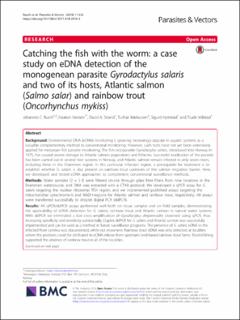| dc.contributor.author | Rusch, Johannes | |
| dc.contributor.author | Hansen, Haakon | |
| dc.contributor.author | Strand, David | |
| dc.contributor.author | Markussen, Turhan | |
| dc.contributor.author | Hytterød, Sigurd | |
| dc.contributor.author | Vrålstad, Trude | |
| dc.date.accessioned | 2020-10-16T13:34:07Z | |
| dc.date.available | 2020-10-16T13:34:07Z | |
| dc.date.created | 2018-06-13T09:34:44Z | |
| dc.date.issued | 2018 | |
| dc.identifier.citation | Parasites & Vectors. 2018, 11 (333), 1-12. | en_US |
| dc.identifier.issn | 1756-3305 | |
| dc.identifier.uri | https://hdl.handle.net/11250/2683409 | |
| dc.description.abstract | Background: Environmental DNA (eDNA) monitoring is growing increasingly popular in aquatic systems as a valuable complementary method to conventional monitoring. However, such tools have not yet been extensively applied for metazoan fish parasite monitoring. The fish ectoparasite Gyrodactylus salaris, introduced into Norway in 1975, has caused severe damage to Atlantic salmon populations and fisheries. Successful eradication of the parasite has been carried out in several river systems in Norway, and Atlantic salmon remain infected in only seven rivers, including three in the Drammen region. In this particular infection region, a prerequisite for treatment is to establish whether G. salaris is also present on rainbow trout upstream of the salmon migration barrier. Here, we developed and tested eDNA approaches to complement conventional surveillance methods. Methods: Water samples (2 × 5 l) were filtered on-site through glass fibre filters from nine locations in the Drammen watercourse, and DNA was extracted with a CTAB protocol. We developed a qPCR assay for G. salaris targeting the nuclear ribosomal ITS1 region, and we implemented published assays targeting the mitochondrial cytochrome-b and NADH-regions for Atlantic salmon and rainbow trout, respectively. All assays were transferred successfully to droplet digital PCR (ddPCR). Results: All qPCR/ddPCR assays performed well both on tissue samples and on field samples, demonstrating the applicability of eDNA detection for G. salaris, rainbow trout and Atlantic salmon in natural water systems. With ddPCR we eliminated a low cross-amplification of Gyrodactylus derjavinoides observed using qPCR, thus increasing specificity and sensitivity substantially. Duplex ddPCR for G. salaris and Atlantic salmon was successfully implemented and can be used as a method in future surveillance programs. The presence of G. salaris eDNA in the infected River Lierelva was documented, while not elsewhere. Rainbow trout eDNA was only detected at localities where the positives could be attributed to eDNA release from upstream land-based rainbow trout farms. Electrofishing supported the absence of rainbow trout in all of the localities. | en_US |
| dc.language.iso | eng | en_US |
| dc.rights | Navngivelse 4.0 Internasjonal | * |
| dc.rights.uri | http://creativecommons.org/licenses/by/4.0/deed.no | * |
| dc.title | Catching the fish with the worm: A case study on eDNA detection of the monogenean parasite Gyrodactylus salaris and two of its hosts, Atlantic salmon (Salmo salar) and rainbow trout (Oncorhynchus mykiss) | en_US |
| dc.type | Peer reviewed | en_US |
| dc.type | Journal article | en_US |
| dc.description.version | publishedVersion | en_US |
| dc.source.pagenumber | 1-12 | en_US |
| dc.source.volume | 11 | en_US |
| dc.source.journal | Parasites & Vectors | en_US |
| dc.source.issue | 333 | en_US |
| dc.identifier.doi | 10.1186/s13071-018-2916-3 | |
| dc.identifier.cristin | 1590871 | |
| cristin.unitcode | 192,16,2,0 | |
| cristin.unitname | Institutt for mattrygghet og infeksjonsbiologi | |
| cristin.ispublished | true | |
| cristin.fulltext | original | |
| cristin.qualitycode | 1 | |

